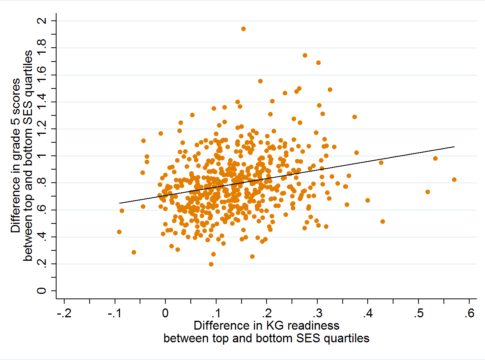
Much of the ongoing debate regarding immigration in the United States involves the question of whether immigrants from low-income countries – especially poor, less-educated immigrants from those countries – should be allowed to settle temporarily or permanently in the United States, and whether people who have migrated in the past should be permitted to remain. One of the flash points of this discussion involves the treatment of Haitian migrants who entered the United States following the devastating earthquake on January 12, 2010 that killed more than 200,000 people and affected a third of the population in Haiti. Haitians who entered the United States in the year following the earthquake have been granted Temporary Protected Status, which is slated to terminate on July 22, 2019. Critics of more liberal immigration policies claim that such migrants from low-income countries are “cast-offs” and impose significant burden on host communities. In contrast, proponents point to the entrepreneurship of recent immigrants, and argue that they represent the engine of future economic growth. However, these debates mostly take place in what is close to an empirical vacuum.
In a recent paper, [1] we present the first evidence, to the best of our knowledge, on the effects of a large influx of refugees or disaster-fleeing migrants on the educational outcomes of incumbent students. We focus specifically on the effects of those who entered the state of Florida – host to the majority of the Haitian disaster-fleeing migrants – in the wake of the 2010 earthquake. (While these migrants are not technically “refugees” in the sense of those fleeing political violence in Syria, for instance, Florida state agencies refer to them as “earthquake refugees,” and we use that language as shorthand in this essay). We make use of rich, longitudinal education microdata from Florida to study this question. These data are exceptionally detailed, allowing us to investigate the effects of Haitian refugees on a variety of incumbent students, including non-refugee Haitian immigrants, U.S.-born students of Haitian ancestry, other non-Haitian immigrant students, and so on. Over 4,000 refugee students entered Florida public schools by the end of the 2009-10 school year, and the overwhelming majority of these students enrolled in four school districts, generating a significant influx of refugee students in certain schools. Figure 1 presents the distribution of Haitian migrants entering Florida public schools during the spring semesters between 2003-04 and 2011-12 school years, illustrating the significant spike in the aftermath of the earthquake.
These new Haitian migrants were extremely low-scoring on state tests when they arrived in Florida. Among those who remained in Florida through at least spring 2012, Haitian earthquake refugees scored an average of 1.35 standard deviations below the state mean in reading and 0.98 standard deviations below the state mean in math in spring 2011, one year after the earthquake. [2] They began to catch up to others statewide over the next year: In spring 2012, Haitian earthquake refugees scored 0.98 standard deviations below the state mean in reading and 0.67 standard deviations below the state mean in math.
A number of studies have examined the effects of immigrants on the labor market outcomes of host communities, [3] and there have been several recent analyses of the effects of immigrants per se on the educational outcomes of incumbent students, though their conclusions have been mixed. [4] But the effects of refugees or other disaster-fleeing migrants might differ from the effects of immigrants on native communities due to the fundamental differences between these two groups in the manner in which they left their home countries. Immigrants typically make conscious choices to leave their countries of origin seeking “a better life” elsewhere. On the other hand, the term “refugee” refers to people who have to flee their countries due to an imminent threat to their lives such as armed conflicts, persecution, and/or natural disasters, and hence are more likely to be representative of, or even less advantaged and more marginalized than, the general population in their countries of origin. Refugees generally are more impoverished with lower earnings than economic migrants, and have lower levels of education and language skills when they arrive. Indeed, we observe in the Florida data that Haitian entrants following the earthquake were much poorer on average than Haitian entrants who arrived in Florida in prior years.
And while refugees ultimately—after a period of six to ten years —have higher labor force participation and employment rates, and have similar welfare participation rates, relative to U.S.-born residents, they often enter the U.S. with low human capital and language skills and have initially poor labor market outcomes and high rates of welfare usage. [5] Therefore, it is plausible to expect that refugees might have a very different (and likely more adverse) effect on incumbent students as school districts and schools shift resources away from native students to accommodate the needs of refugees.
The biggest challenge in revealing the causal effect of refugees on incumbent communities is that refugee students are not randomly assigned to schools and communities. In fact, prior research has shown that refugees, and recent immigrants in general, are more likely to settle in neighborhoods with larger shares of immigrants from their country of origin. [6] To deal with this selection issue, we make use of the within-school, across-grade variation in the volume of entering refugees to explore the effects on the educational outcomes of existing students including test scores, disciplinary incidents, and student mobility across schools. Put differently, we compare the outcomes of incumbent students in grades where relatively more Haitian earthquake refugees entered a school to those in grades in the same school where relatively few refugees entered the school. This way, we don’t have to worry about whether incumbent students in schools that attract more Haitian refugees are different from incumbent students in other schools – a possibility that could lead to misleading estimates of the effects of refugees if we compared incumbent student outcomes across schools. We also adopt empirical strategies to deal with the possibility that school administrators might strategically assign Haitian refugees to grades other than those predicted by their birth dates; we find little evidence to suggest that schools behaved strategically in this manner.
We find evidence that the effects of refugees on the educational outcomes of incumbent students in the year of the earthquake or in the two years that follow are either precisely estimated zero or very small positive, and we find no evidence of negative effects of refugees on incumbent students’ school outcomes.
The richness of the Florida data – especially given that the Florida Departments of Education and Health merged birth and school records for the purpose of the research agenda in which this study is a part — allows us to investigate the effects of Haitian earthquake migrants on many different types of incumbent students. We look separately at the effects on the outcomes of Haitian-born incumbent students, other immigrant students, U.S.-born Haitian Creole speakers, other U.S.-born black students, other U.S.-born non-black students, limited English proficient students, those who are not English language learners, children with mothers who have less than a high school diploma, children with mothers who have a high school diploma but no other education, and children whose mothers attended college. In all cases, the estimated effects of Haitian earthquake refugees are mostly positive, but never particularly large.
Understanding the effects of refugees on incumbent communities is more important than ever as the world faces the second largest refugee crisis in a century. We find no significant adverse effect of refugees on the educational outcomes of incumbent students including test scores, disciplinary incidents, and student mobility across schools. While we tend to find many more positive estimates than negative estimates, the weight of the evidence indicates that refugees have either a precisely estimated zero or very small positive effect on incumbent students’ outcomes, both immediately following the arrival of refugees and up to two years afterward.
That said, several factors might hinder the generalizability of our findings to other contexts. For instance, the effects of refugees fleeing the devastation of natural disasters such as the earthquake in Haiti might be different than the effects of refugees escaping violence and political persecution. Further, Florida has an established and sizeable Haitian immigrant population and Haitian refugees enrolled in schools with considerable Haitian student populations. These schools might already have support systems in place to help recent immigrants from Haiti such as Haitian Creole speaking counselors, and hence might be more prepared to accommodate an influx of Haitian refugees, minimizing the adverse effects on existing students. Such support systems might not exist in other contexts (such as the Syrian refugee crisis in Europe) and hence the negative externalities of refugees on incumbent students might be more severe. That said, Haitian Creole speakers were still a small minority of incumbent students in almost every refugee-receiving school prior to the 2010 earthquake. Just six percent of the incumbent student body of the typical refugee-receiving school spoke Haitian Creole, and only half of all Haitian immigrants (not counting native-born Haitian Creole speakers) are considered limited English proficient. Limited English proficient Haitian Creole speakers account for more than 10 percent of the incumbent student body population in only 78 schools, and more than 20 percent of the incumbent student population in just 26 schools. Therefore, it is unlikely that substantial educational or social services for Haitian immigrants existed in all but a relative handful of schools.
In summary, there appears to be little evidence that a sizeable influx of refugees – at least, not the set of Haitian earthquake-related migrants who are at the center of the current controversy regarding the end of Temporary Protected Status for Haitians – has short-term negative consequences on native students. Taken together with new evidence that after a period of adjustment, refugees have similar economic outcomes, across several dimensions, to comparison U.S.-born natives, and ultimately pay more in taxes than they receive in benefit, these findings indicate that the potential negative externalities associated with refugee admissions are likely lower than some may worry.
— David Figlio and Umut Ozek
 David Figlio is Dean of the School of Education and Social Policy at Northwestern University and research associate at the National Bureau of Economic Research. Umut Ozek is a principal researcher with CALDER and American Institutes for Research.
David Figlio is Dean of the School of Education and Social Policy at Northwestern University and research associate at the National Bureau of Economic Research. Umut Ozek is a principal researcher with CALDER and American Institutes for Research.
This post originally appeared as part of Evidence Speaks, a weekly series of reports and notes by a standing panel of researchers under the editorship of Russ Whitehurst.
The author(s) were not paid by any entity outside of Brookings to write this particular article and did not receive financial support from or serve in a leadership position with any entity whose political or financial interests could be affected by this article.
Notes:
1.David Figlio and Umut Özek, “Unwelcome Guests? The Effects of Refugees on the Educational Outcomes of Incumbent Students,” National Bureau of Economic Research working paper 23661, 2017.
2. The figures are nearly identical – 1.34 and 0.97 – for the full set of Haitian earthquake refugees present in Florida schools in spring 2011.
3. A good summary of the extensive extant literature on this subject is found in Yusuf Akgündüz, Marcel van den Berg, and Wolter Hassink, “The Impact of Refugee Crises on Host Labor Markets: The Case of the Syrian Refugee Crisis in Turkey”, IZA Discussion Paper 8841, 2015.
4. See, for example, Julian Betts and Robert Fairlie, “Does Immigration Induce ‘Native Flight’ from Public Schools into Private Schools?” Journal of Public Economics, 2003; Giorgio Brunello and Lorenzo Rocco, “The Effect of Immigration on the School Performance of Natives: Cross Country Evidence Using PISA Test Scores”, Economics of Education Review, 2013; Elizabeth Cascio and Ethan Lewis, “Cracks in the Melting Pot: Immigration, School Choice, and Segregation”, American Economic Journal: Economic Policy, 2012; Charlotte Geay, Sandra McNally, and Shqiponja Telhaj, “Non-Native Speakers of English in the Classroom: What are the Effects on Pupil Performance?” Economic Journal, 2013; Eric Gould, Victor Lavy, and Daniele Paserman, “Does Immigration Affect the Long-Term Educational Outcomes of Natives? Quasi-Experimental Evidence”, Economic Journal, 2009; Jennifer Hunt, “The Impact of Immigration on the Educational Attainment of Natives”, Journal of Human Resources, 2016; Peter Jensen and Astrid Wurtz-Rasmussen, “The Effect of Immigrant Concentration in Schools on Native and Immigrant Children’s Reading and Math Skills”, Economics of Education Review, 2011; Asako Ohinata and Jan van Ours, “How Immigrant Children Affect the Academic Achievement of Native Dutch Children”, Economic Journal, 2013; and Nicole Schneeweis, “Immigrant Concentration in Schools: Consequences for Native and Migrant Students”, Labour Economics, 2015.
5. See, for example, Philip Connor, “Explaining the Refugee Gap: Economic Outcomes of Refugees Versus Other Immigrants”, Journal of Refugee Studies, 2010; William Evans and Daniel Fitzgerald, “The Economic and Social Outcomes of Refugees in the United States: Evidence from the ACS”, National Bureau of Economic Research working paper 23498, 2017; Miriam Potocky-Tripodi, “The Role of Social Capital in Immigrant and Refugee Economic Adaptation”, Journal of Social Service Research, 2004.
6. David Card, “Immigrant Inflows, Native Outflows, and the Local Labor Market Effects of Higher Immigration”, Journal of Labor Economics, 2001.






